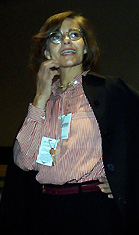
| T H E N I H C A T A L Y S T | M A R C H – A P R I L 2001 |
|
|
|
Angiogenesis
Research
|
|
by
Fran
Pollner
|
 |
|
The
Angiogenesis Foundation
|
A few years ago, angiogenesis was hot news—albeit sometimes manufactured and distorted—as cancer patients responded to a front-page story in the lay media that implied cancer could be cured by angiostatin and endostatin, two angiogenesis inhibitors.
The news was manufactured in that angiogenesis wasn’t "news"; it was a biological phenomenon whose process and implications for human health had been studied for decades, perhaps most notably in the laboratory of Judah Folkman at Children’s Hospital in Boston. It was distorted because, caveats notwithstanding, the context and quotes surrounding the reported mouse findings invited instant extrapolation to human primary and metastatic cancer.
Clarifications ensued and eventually the noise subsided. Angiogenesis research, however, did not subside. At NIH, intramural research aimed at understanding angiogenesis, and how to inhibit or promote it in different disease settings, has been ongoing—and was the subject of a plenary session at the last NIH Research Festival.
New blood vessel growth, or its absence, can have both desirable and damaging results, William Stetler-Stevenson, chief of NCI’s Extracellular Matrix Pathology Section, observed in his introductory overview of this "rapidly expanding, controversial field." Angiogenic sproutingcan compromise normal function, as in diabetic retinopathy, or compensate for compromised function, as in collateral vessel formation in response to coronary atherosclerosis. Insufficent vascularization is a concomitant of Alzheimer’s and other dementias, increased vascularization a hallmark of tumor growth and metastasis.
Clinical trials at NIH involving angiogenesis have focused on angiogenesis inhibition in a variety of cancer settings and, Stetler-Stevenson summed up, are suggesting that this approach delays and diminishes—but does not eliminate—cancer progression.
 |
|
Giovanna
Tosato
|
Testing the Limits
Vasostatin inhibited both angiogenesis and tumor growth in studies undertaken by Giovanna Tosato, head of the Molecular and Cell Biology Section at the NCI Department of Experimental Transplantation and Immunology—and the scientist who discovered vasostatin’s activity and identified it as a fragment of calreticulin, a ubiquitous, intracellular protein that serves as a calcium depot.
Mice injected with Burkitt cells "displayed tumor restraint" in the presence of vasostatin, she reported, noting that vasostatin "did not abolish growth, but did delay it." Similarly, in studies with human-derived cells from melanoma, rhabdomyosarcoma, Hodgkin’s lymphoma, Wilm’s tumor, and colon and breast cancers, subcutaneous vasostatin injection inhibited endothelial cell proliferation, angiogenesis, and tumor growth.
Cytostatic rather than cytotoxic action of antiangiogenic agents against tumor cells was reported by other investigators as well, and there was general consensus among the speakers that angiogenesis inhibitors would not be effective as solo therapy but could theoretically work very well in combination with conventional cancer chemotherapeutic regimens.
 |
|
William
Figg
|
The operating hypothesis in the lab of William Figg, chief of the Clinical Pharmacokinetics Section of the NCI Department of Developmental Therapeutics, is that "tumor cells release growth factors to recruit endothelial cells." Figg is an investigator in several NCI clinical trials of antiangiogenic agents; in the lab, he and his team have been dissecting the antiangiogenic properties of thalidomide and, he said, "We think we’ve identified the active metabolite" of thalidomide that actually exerts the inhibitory effect on angiogenesis seen in clinical trials involving patients with glioma, Kaposi’s sarcoma (KS), prostate cancer, breast cancer, and multiple myeloma. "We had speculated that there are five metabolites and, after several years, we have finally synthesized one—MW3, a 5’OH metabolite of thalidomide—that does inhibit angiogenesis in some of our model systems," he said.
Clinical results among KS, multiple myeloma, and prostate cancer patients have been encouraging, Figg said, noting that declines in prostate-specific antigen in the prostate cancer cohort, all of whom had failed hormone ablation and nearly all of whom had bone metastases, are correlating with improvements seen on PET scan.
However, he added, "don’t oversell this approach. It looks like angiogenesis needs to be combined with other antitumor approaches (radiation, hormonal, surgery, chemotherapy). That would be the optimal approach." He noted that there are two trials (on campus) testing such combinations in prostate cancer patients: one of docetaxel (Taxotere) and thalidomide and the other of leuprolide acetate (Leupron) and thalidomide.
Turning to Gene Therapy
 |
|
Steve
Libutti
|
Steve Libutti, a clinical investigator in NCI’s Surgery Branch and chair of a clinical trial of thalidomide in patients with recurrent colorectal cancer, focused on the harnessing of endogenous anti-angiogenic agents as an anticancer strategy.
He noted that scientists have been unearthing endogenous inhibitors of the endogenous promoters of angiogenesis (such as vascular endothelial and fibroblast growth factors) at an "exponential rate."
The reasons for this anti-angiogenesis drive, he said, are clear: Blood vessels are similar across all tumor histologies, resistance does not appear to be an issue because endothelial cells have low mutagenic potential, toxicity appears to be minimal, and there may be synergy with conventional cancer therapy.
At this point, he added, the main disadvantage is the need for chronic administration, because blood vessels will resume growing upon discontinuation of the angiogenesis inhibitor. His solution is "allowing the host to become a factory" of the chosen therapeutic agent—endostatin, in the studies he’s involved in—through gene therapy.
"We have not discovered the perfect vector system yet," he said, summarizing the relative merits of tumor-directed vs. systemic delivery. The latter might be selected for patients with micrometastases. In mouse studies using recombinant adenovirus and murine endostatin, delivered intravenously into the liver, sustained circulating endostatin yielded 40 percent inhibition of tumor growth in injected human melanoma cells; adenovirally delivered pigment epithelial derived factor also inhibited mesothelioma growth in another animal study. Neither intranasal nor intraperitoneal routes of delivery were successful.
Tumor-targeted delivery, he continued, would be suited to the large-tumor setting. For this purpose, he and his team have explored vaccinia virus, which selectively targets tumor tissue. In a mouse model, pretreatment with recombinant vaccinia-EMAPII, a tumor-derived cytokine, yielded diminished tumor size after TNF injection.
The team is now testing an attenuated salmonella vector, an as yet "untapped" vector source whose sensitivity to antibiotics, Libutti observed, would represent a "safety margin" in forthcoming clinical trials should the vector need to be eliminated for any reason.
The team is embarking
on a Phase I clinical trial involving patients with metastatic melanoma that
will test the attenuated vector alone. If it proves to target to human tumors,
"we’ll send in a gene," Libutti said. ![]()
For More Info
![]() NICHD investigator Brant
Weinstein has produced a videotape of angiogenesis in the zebrafish that
tracks two signaling pathways and compresses 10 hours of blood vessel formation
into a few minutes; he also has established a website
on the vascular anatomy of the zebrafish:
NICHD investigator Brant
Weinstein has produced a videotape of angiogenesis in the zebrafish that
tracks two signaling pathways and compresses 10 hours of blood vessel formation
into a few minutes; he also has established a website
on the vascular anatomy of the zebrafish:
![]() There is an NIH interest group on Tumor Angiogenesis and Invasion. Go to the
interest group website and click
onto the group name.
There is an NIH interest group on Tumor Angiogenesis and Invasion. Go to the
interest group website and click
onto the group name.
![]() There is a website
with a list of angiogenesis inhibitors in clinical trials in the NCI trials
database.
There is a website
with a list of angiogenesis inhibitors in clinical trials in the NCI trials
database.
Her laboratory and animal work have suggested to Hynda Kleinman that thymosin beta-4 (Tß4) may be "the angiogenic molecule in metastasis." Prospecting for the genes through which the angiogenic properties of endothelial basement membrane cytokines are activated, Kleinman has found ample evidence for a pivotal role for Tß4. In studies of endothelial cells undergoing early steps in angiogenesis, Kleinman, who is chief of the NIDCR Cell Biology Section, found one gene—Tß4—that was upregulated and later shown by her group to be angiogenic. This molecule, she noted, was recently found by others to be one of three genes consistently upregulated in metastatic tumors. Tß4, Kleinman summed up, is "present in wound fluid and metastatic tumor cells. It promotes the migration of coronary artery endothelial cells. In the rat model, it works to re-epithelialize the corneal eye surface. Tested topically and intraperitoneally in rats, it decreases wound width amazingly." She sees therapeutic
potential for Tß4 in treating wounds in elderly, diabetic, and other
patients with impaired wound healing and (in collaboration with investigators
from NEI, the Uniformed
Services University of the Health Sciences in Bethesda, Md., and George
Washington University in Washington, D.C.) is on the threshold of
a clinical trial to test that expectation. |